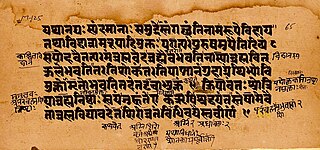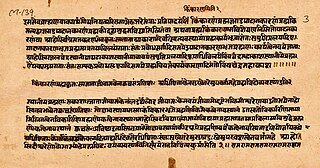
The Upanishads are late Vedic Sanskrit texts of Hindu philosophy which form the foundations of Hinduism. They are the most recent part of the Vedas, the oldest scriptures of Hinduism, and deal with meditation, philosophy, and ontological knowledge; other parts of the Vedas deal with mantras, benedictions, rituals, ceremonies, and sacrifices. Among the most important literature in the history of Indian religions and culture, the Upanishads played an important role in the development of spiritual ideas in ancient India, marking a transition from Vedic ritualism to new ideas and institutions. Of all Vedic literature, the Upanishads alone are widely known, and their central ideas are at the spiritual core of Hinduism.
The following outline is provided as an overview of and topical guide to Hinduism:

The Brahmanas are Vedic śruti works attached to the Samhitas of the Rig, Sama, Yajur, and Atharva Vedas. They are a secondary layer or classification of Sanskrit texts embedded within each Veda, often explain and instruct Brahmins on the performance of Vedic rituals. In addition to explaining the symbolism and meaning of the Samhitas, Brahmana literature also expounds scientific knowledge of the Vedic Period, including observational astronomy and, particularly in relation to altar construction, geometry. Divergent in nature, some Brahmanas also contain mystical and philosophical material that constitutes Aranyakas and Upanishads.
The Aranyakas are the part of the ancient Indian Vedas concerned with the meaning of ritual sacrifice. They typically represent the later sections of the Vedas, and are one of many layers of the Vedic texts. The other parts of the Vedas are the Samhitas, Brahmanas (commentary), and the Upanishads.
The Atharva Veda is the "knowledge storehouse of atharvāṇas, the procedures for everyday life". The text is the fourth Veda, but has been a late addition to the Vedic scriptures of Hinduism.

The Yajurveda is the Veda primarily of prose mantras for worship rituals. An ancient Vedic Sanskrit text, it is a compilation of ritual-offering formulas that were said by a priest while an individual performed ritual actions such as those before the yajna fire. Yajurveda is one of the four Vedas, and one of the scriptures of Hinduism. The exact century of Yajurveda's composition is unknown, and estimated by Witzel to be between 1200 and 800 BCE, contemporaneous with Samaveda and Atharvaveda.

The Isha Upanishad is one of the shortest Upanishads, embedded as the final chapter (adhyāya) of the Shukla Yajurveda. It is a Mukhya Upanishad, and is known in two recensions, called Kanva (VSK) and Madhyandina (VSM). The Upanishad is a brief poem, consisting of 17 or 18 verses, depending on the recension.

The Māṇḍūkya Upaniṣad is the shortest of all the Upanishads, and is assigned to Atharvaveda. It is listed as number 6 in the Muktikā canon of 108 Upanishads.

The Mundaka Upanishad is an ancient Sanskrit Vedic text, embedded inside Atharva Veda. It is a Mukhya (primary) Upanishad, and is listed as number 5 in the Muktika canon of 108 Upanishads of Hinduism. It is among the most widely translated Upanishads.

The Prashnopanishad is an ancient Sanskrit text, embedded inside Atharva Veda, ascribed to Pippalada sakha of Vedic scholars. It is a Mukhya (primary) Upanishad, and is listed as number 4 in the Muktika canon of 108 Upanishads of Hinduism.

The Shvetashvatara Upanishad is an ancient Sanskrit text embedded in the Yajurveda. It is listed as number 14 in the Muktika canon of 108 Upanishads. The Upanishad contains 113 mantras or verses in six chapters.
Muktikā refers to the Sanskrit language anthology of a canon of 108 Upaniṣhads. The date of composition of each is unknown, with the oldest probably from about 800 BCE. The Principal Upanishads were composed in the 1st millennium BCE, most Yoga Upanishads composed probably from the 100 BCE to 300 CE period, and seven of the Sannyasa Upanishads composed before the 3rd century CE.

The Mahavakyas are "The Great Sayings" of the Upanishads, declaring the relation between Atman and Brahman, as characterized by Vedanta philosophy. Most commonly, Mahavakyas are considered four in number,
- Prajñānam Brahma - "Knowledge is Brahman," or "Brahman is Knowledge"
- Ayam Ātmā Brahma - "This Self (Atman) is Brahman"
- Tat Tvam Asi - "That you are"
- Aham Brahmāsmi - "I am Brahman"
Prasthanatrayi, literally, three sources , refers to the three canonical texts of theology having epistemic authority, especially of the Vedanta schools. It consists of:
- The Upanishads, known as Upadesha prasthana, and the Śruti prasthāna, especially the Principal Upanishads.
- The Brahma Sutras, known as Sutra prasthana or Nyaya prasthana or Yukti prasthana
- The Bhagavad Gita, known as Sadhana prasthana, and the Smriti prasthāna
Adi Shankara, a Hindu philosopher of the Advaita Vedanta school, composed a large body of literary works which are central to the Advaita Vedanta interpretation of the Prasthanatrayi—the canonical texts consisting of the Upanishads, the Bhagavad Gita and the Brahma Sutras. His works deal with logically establishing the doctrine of Advaita Vedanta.

The Kena Upanishad is a Vedic Sanskrit text classified as one of the primary or Mukhya Upanishads that is embedded inside the last section of the Talavakara Brahmanam of the Samaveda. It is listed as number 2 in the Muktikā, the canon of the 108 Upanishads of Hinduism.
The Taittirīya Upanishad is a Vedic era Sanskrit text, embedded as three chapters (adhyāya) of the Yajurveda. It is a mukhya Upanishad, and likely composed about 6th century BC.

The Samaveda, is the Veda of melodies and chants. It is an ancient Vedic Sanskrit text, and part of the scriptures of Hinduism. One of the four Vedas, it is a liturgical text which consists of 1,549 verses. All but 75 verses have been taken from the Rigveda. Three recensions of the Samaveda have survived, and variant manuscripts of the Veda have been found in various parts of India.
Samanya Upanishads or Samanya Vedanta Upanishads are minor Upanishads of Hinduism that are of a generic nature. They were composed later and are classified separate from the thirteen major Principal Upanishads considered to be more ancient and connected to the Vedic tradition.

The Swaminarayan Bhashyam (Svāminārāyaṇabhāṣyam) is a five-volume Sanskrit bhashya, or commentary, on the Prasthanatrayi (Prasthānatrayī) - the ten principal Upanishads (Upaniṣads), the Bhagavad Gita (Bhagavadgītā), and the Brahmasutras (Brahmasūtras) - which establishes the principles taught by Swaminarayan as perceived by the BAPS.













